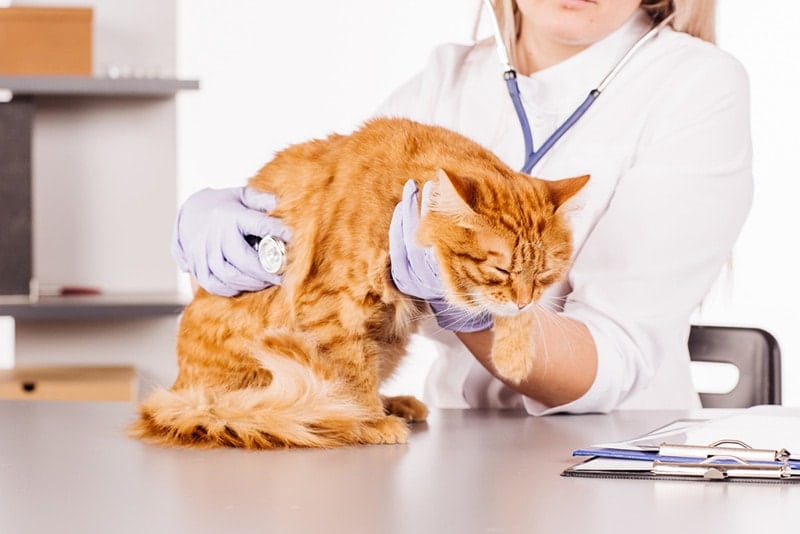Do you have a beautiful stray that lingers in your neighborhood? You might want to make friends with them, but it will prove to be quite a task. Stray cats often tug on the heartstrings of animal lovers. So, how exactly do you warm up the heart of a forgotten feline, letting them know that you mean them no harm?
Providing food or shelter alone isn’t enough to make a difference in the stray cat community, but volunteering your time, energy, and money can really help facilities aiming to reduce the number of homelessness in the feline world. Here are seven methods you can try to win the trust of your feline visitor.
The 7 Tips on How to Get a Stray Cat to Trust You
1. Vet Them
Even if you don’t plan on taking the stray into your home, there are ways to help them. Infection, disease, and illness run rampant in the stray cat community. To alleviate many of the associated risks, programs are put in place to help animals in the situation.
The most popular is a TNR program, which stands for trap, neuter, and release. Essentially, you would report to animal services to help you trap the stray, bring them into an authorized veterinary facility, have that animal spayed or neutered, and release them back into the wild.
Neutering stray cats is the best help that you can provide to them and our environment, hence why it’s number one on this list. Having stray cats checked by a vet before attempting to get too close to them or feed them is important for your safety and as a humanitarian measure.
Not only will cats receive proper surgeries to prevent them from reproducing, but they also get essential vaccinations and other care to ensure they are healthy before re-releasing.

2. Feed Them
A sure way to worm your way into a cat’s heart is to give them yummy food. A stray cat on the streets never knows when they’ll get their next meal. If you become a frequent meal stop for them, it’ll give them a reason to hang around.
The more you can show consistency, the more their trust will start to form. While they might scurry off the first few times, they do see you while eating, and in time, they might just stay. Soon after, they might even tolerate you approaching them while eating. And if you’re lucky, eventually, they will let you pet them. And who knows? They might even figure out just how much they like it!
Remember that if you put food out for strays, you might also attract other unwanted guests, like raccoons, possums, and skunks (or any other wildlife in your particular location). So, you might want to monitor guests coming over for dinner to ensure no unwanted visitors are stealing meals.
3. Give Them Shelter
Every kitty needs a warm spot to rest their head. If you provide a suitable shelter for the neighborhood strays, you’re giving them a haven in a very unforgiving world. If they take to the shelter, you might just have a live-in houseguest on the porch or back deck.
Cats having shelter is especially important in colder months. If temperatures are frigid outside, it can lead to sickness, frostbite, and even death.
It doesn’t take much to throw a cat box together. You can do it very inexpensively, or you can get really creative. You can make cat boxes from old wooden crates, totes, cardboard, and a number of other materials.
You can follow online tutorials to make something eye-catching or creative, but don’t underestimate simplicity.

4. Talk to Them
A major part of socialization is to speak gently to them. Without trying to approach them, it is beneficial to acclimate them to your voice and your presence. When you notice you have feline guests, talk from a distance in a pleasing tone and don’t make any sudden movements.
The more the cat grows accustomed to your presence and kind voice, the more they can acclimate to you. With patience and respect, the cat might trust you more and more as time passes—which is the goal! If the cat’s body language seems on edge or tense, back off and try again another time.
6. Give Them Treats
Once you start to establish trust, see if they will eat a treat right out of your hand. Make it something yummy that their taste buds can’t say no to. Maybe their senses will overtake detachment for just a moment, being willing to take that risk.
You can get really creative treats if you want to. You can buy a selection at the store or online. Or you can take to Pinterest and get all sorts of yummy recipes. You can make it from the comfort of your own kitchen. Regardless of the type of treat, the feral kitties in your neighborhood will find it hard to say no.
Eventually, they might even come closer and closer, taking a treat right out of your hand. It all depends on how persuasive your argument is!
7. Become a Caretaker for a Colony
Becoming a caretaker for a colony of feral or stray cats is a very big responsibility. These animals will quickly become dependent on your care and resources. If you ever should move or decide to end caretaking, you will need a backup plan for who will fill your shoes.
Before you undertake an entire colony of cats, work closely with your local Humane Society or welfare group to get the best information upfront.


Contribute in Other Ways
Aside from making friends with your local kitty colony, there are other ways you can also help. Shelters and rescues always seek donations to care for less fortunate animals. The closer you are to these foundations, the easier it will be for you to contribute effectively.
If you still need to do so, get in touch with local programs and organizations to see what your options are.
Stray vs. Feral Cats
You might think stray and feral cats are the same, but this is incorrect. However, the distinction is easy to understand. Stray cats are those that were domesticated at one point in time. That means they were socialized with people and likely kept indoors at some point in their life.
On the other hand, feral cats have never had any human contact and might be much more challenging to tame. Often, feral cats are almost impossible to domesticate, as they are already set in their ways.
A stray cat might be able to be rehomed into a family who can care for them. However, feral cats are often unadoptable, and many shelters will not take them. So if you plan to take your newfound homeless kitty to a shelter, you might want to consider the distinction before trying.
Unfortunately, many feral cats are often put to sleep if they are brought in, as they are deemed unadoptable. Some shelters might reject them entirely, not accepting them into the facility.
Understanding the difference can help you set your expectations with your newfound relationship. If you plan to win their trust so you can have them indoors, a stray cat might reacclimate to living in a home. However, most feral cats will never be able to live inside as a companion.
Most of them are very fearful and cannot establish the relationship necessary to have a domestic life. However, if you have stray kittens, even those born to feral cats can be socialized enough to become pets. However, you have to intervene very early to ensure success.

How Can You Tell the Difference?
If you aren’t sure, there are ways you can tell if the cat in question is feral or a stray. Stray cats will typically exhibit some behaviors that feral cats do not.
Stray cats might come up on porches, decks, and people’s garages or cars. Feral cats are much less likely to approach or seek refuge in man-inhabited areas.
That doesn’t mean, of course, that feral cats don’t deserve care and compassion from human people. You can still try to win them over. However, you might only achieve a distant level of friendship rather than being up close and personal.
In any case, feral and stray cats are sure to appreciate any goodies, shelter, and other care you wish to provide.
The Importance of Caring for Your Own Cats
This likely goes without saying, but we still want to give it a mention. One of the best things you can do to help feral or stray cats is to not contribute to the problem. That means vaccinating, spaying or neutering, and treating your domesticated cats.
Allowing your domestic cats to go outside to mingle with feral or stray cats can wind up in unwanted pregnancy, disease, and several other negative consequences. So, always make sure that if you’re trying to win over a stray or feral cat, you’re being utterly responsible with your own.

Conclusion
Building trust is a thing that takes time. No matter how impatient you might feel about it, it won’t happen overnight. Ultimately, the goal is to make the cat as comfortable as possible. Different animals take different lengths of time to become acclimated to new scenarios.
Remember that if the cat you’re trying to appeal to is feral and not just a stray, the likelihood of you ever having a bond or living under the same roof is very low. However, you can still ensure your wild neighborhood kitties‘ safety and comfort.
Featured Image Credit: evgenii mitroshin, Shutterstock












